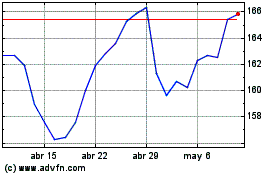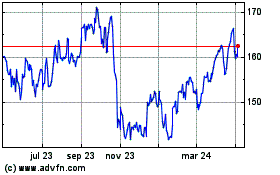Oil Buoyed by Tightening Global Supplies
10 Mayo 2019 - 9:02AM
Noticias Dow Jones
By Dan Molinski
--Oil prices edged higher Friday as investors shrugged off a
Trump administration decision to impose higher tariffs on Chinese
imports, and instead focused on continuing supply concerns in
Venezuela, Iran and Libya.
--West Texas Intermediate futures, the U.S. oil benchmark,
recently rose 0.2% to $61.81 a barrel on the New York Mercantile
Exchange.
--Brent crude, the global oil benchmark, was up 0.5% at $70.74 a
barrel on London's Intercontinental Exchange.
HIGHLIGHTS
U.S.-China Trade: Oil prices have been on a bumpy road this week
amid shifts in sentiment over trade negotiations between the U.S.
and China, the world's two largest economies. On Friday morning,
President Trump made good on a threat to raise tariffs on Chinese
goods, but investors were nonetheless encouraged that he didn't
signal any derailment to the overall trade talks.
"Talks with China continue in a very congenial manner -- there
is absolutely no need to rush -- as Tariffs are NOW being paid to
the United States by China of 25% on 250 Billion Dollars worth of
goods & products. These massive payments go directly to the
Treasury of the U.S.," Mr. Trump said in a Twitter post.
Analysts said oil investors also aren't overlooking the
price-supportive, ongoing risks to global crude supplies. Tough
U.S. sanctions against Venezuela and Iran have significantly curbed
oil exports from those two countries -- both members of the
Organization of the Petroleum Exporting Countries -- while
crisis-torn Libya, also an OPEC member, is on investors' radar.
"With U.S.-China trade deal hopes revived, we could be on the
verge of another oil rally," Phil Flynn, senior market analyst at
Price Futures in Chicago, said in a note to clients Friday. "On top
of that we still have supply risks and threats. Can't forget
Venezuela, Iran, and Libya."
Iran, Venezuela: Sanctions on Iran that began last year have
already pushed Iranian exports to below 1 million barrels a day
from 2.5 million previously, while Venezuelan exports are slowing
to a trickle as Washington tries to force embattled President
Nicolas Maduro from power.
"Venezuelan exports may also fall further too, as the U.S. is
likely to squeeze the country economically, implying further
sanctions, following the failed uprising against the Maduro regime
last week," said analysts at Energy Aspects in a note.
INSIGHT
Chevron Exits: Oil markets were also focused this week on a
potential bidding war between Chevron Corp. and Occidental
Petroleum, both of which wanted to buy shale-rich Anadarko
Petroleum. But after Occidental made an offer higher than Chevron's
initially accepted offer of $33 billion, Chevron decided to make no
counteroffers, and instead will walk away with a $1 billion breakup
fee.
"Chevron wields an enviable growth profile among the Majors. It
is already a leader in U.S. tight oil, underpinned by its
low-royalty, contiguous acreage position throughout the Permian,"
said Greig Aitken, director of M&A Research at Wood Mackenzie.
"We thought Chevron had room to up its offer without destroying
value -- and in oil and gas M&A, that's generally an
achievement for any buyer. But it looks like Chevron wasn't content
with just breaking even."
AHEAD
-- Baker Hughes releases its rig-count report on Friday at 1
p.m. ET.
--The EIA's monthly Drilling Productivity Report, which details
oil production from the U.S.'s main shale regions, is due for
release Monday.
--OPEC's monthly oil market report is due Tuesday.
Write to Dan Molinski at dan.molinski@wsj.com
(END) Dow Jones Newswires
May 10, 2019 09:47 ET (13:47 GMT)
Copyright (c) 2019 Dow Jones & Company, Inc.
Chevron (NYSE:CVX)
Gráfica de Acción Histórica
De Mar 2024 a Abr 2024

Chevron (NYSE:CVX)
Gráfica de Acción Histórica
De Abr 2023 a Abr 2024
